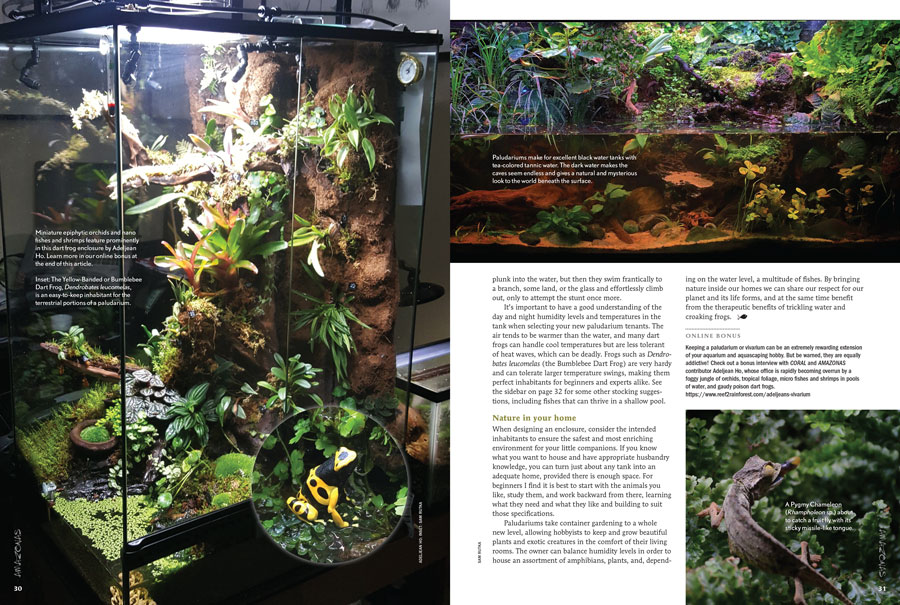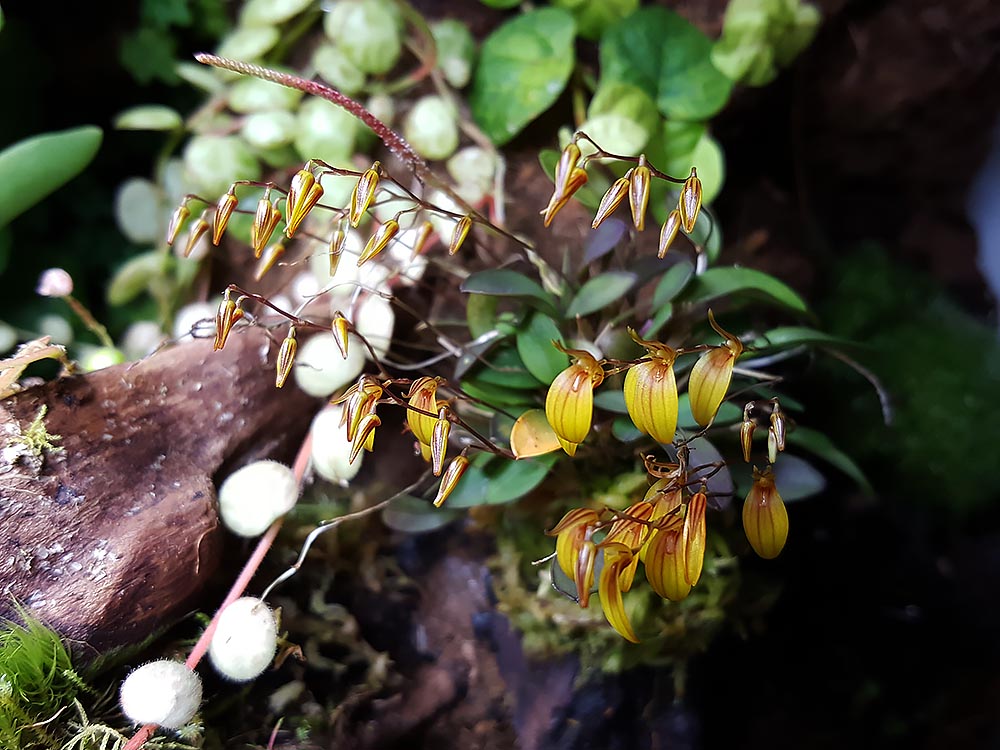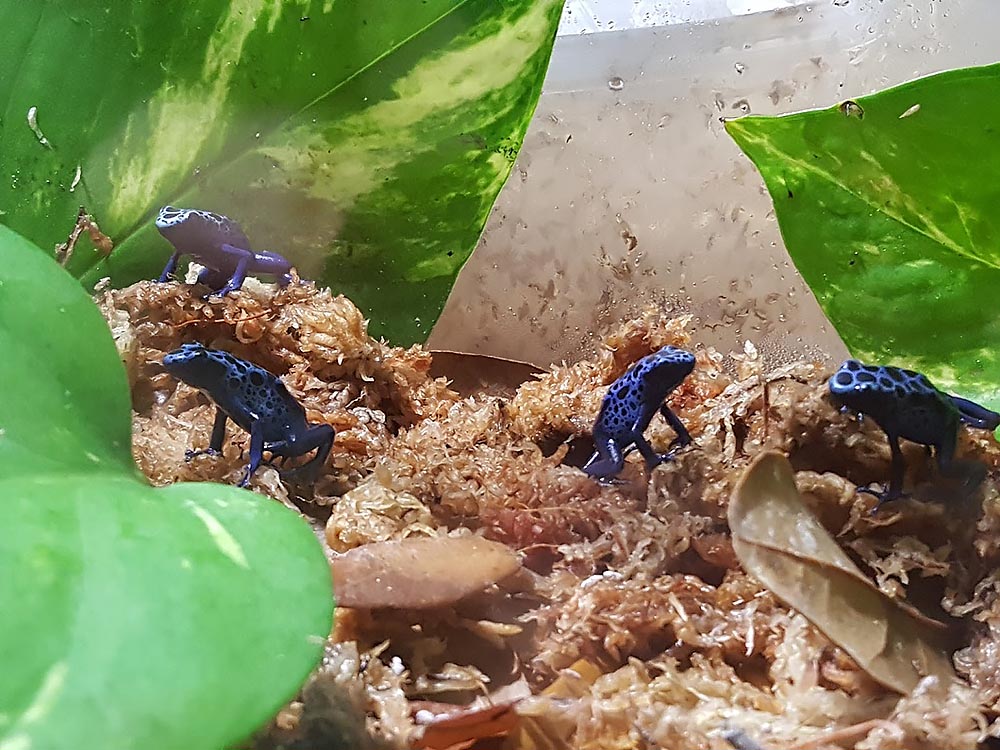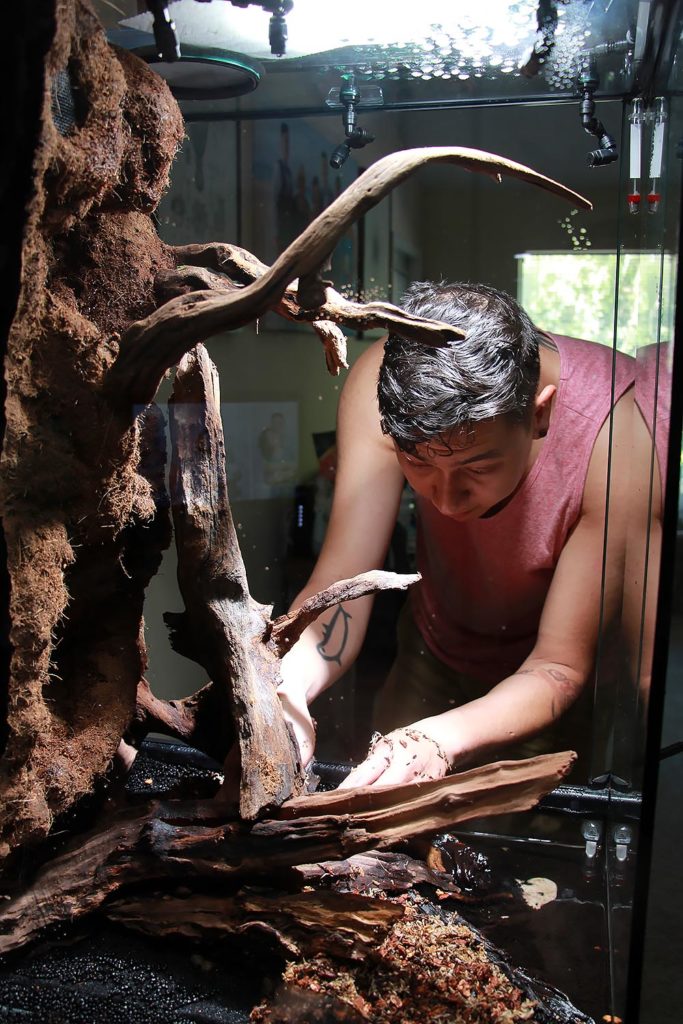
The closing pages of Sam Rutka’s article, Behold…The Paludarium, from the Jan/Feb 2018 issue of AMAZONAS Magazine.
Our interest in fishes often comes along with tangential hobbies. That is to say, if you like keeping freshwater fish, you might branch out into reef tanks. Ask around among your friends; it seems folks interested in coral or planted tanks are often also rabidly into orchids or exotic amphibians, or maybe an avid gardener; plus we often seek to propagate whatever we can along the way. Here we talk with Dr. Adeljean Ho, a fish researcher in Florida, who exemplifies the multi-discipline approach to recreating a tropical environment in miniature.
A Tale of Combining Passions
Tucked quietly into the tail end of Sam Rutka’s Behold…The Paludarium article (from the January/February 2018 issue of AMAZONAS) was a mention of an online bonus; an interview with Dr. Adeljean Ho, whose vivarium is featured on page 30 of the issue (left in the image above).
This contained habitat includes a wide range of orchids and other plants, along with dart frogs, shrimp and fish, in a well-constructed living environment that will continue to grow and flourish for years to come. AMAZONAS Sr. Editor Matt Pedersen (himself a former orchid breeder with a recently sparked curiosity in dart frogs) interviewed Dr. Ho, a long-time repeat contributor to both CORAL and AMAZONAS Magazines, about this expansion of his interests beyond the aquarium-centric world; indeed, many of us share communal interests.
What started out as a planned “short” online bonus feature rapidly evolved into a feature-length interview. Our current plan now is to feature a sizeable portion of this interview in an upcoming issue of AMAZONAS, along with the complete, unabridged interview, being published online at that time.
Interview Preview
For now, we present you with a few selections from the forthcoming interview; we’d love to hear about your own passions that stem from or relate to your interest in freshwater aquariums; tell us in the comments below.
MP: So how did things go from one 20-gallon tank to an office full of plants, frogs, fish, and fog?
AH: The main impetus for starting up my 20-gallon to house the orchids is that [I] could do it easily. But it took a lot of manual labor. So I quickly moved away from the concept of an orchid holding system that would simply keep up humidity, to something completely automated that would take almost no input on my end.
My hobby went from being a simple glass box to something that is much more naturalistic. What I have now looks like a slice of the jungle….
Learn all about how Dr. Ho planned and built this vivarium in a future issue of AMAZONAS.
MP: OK, since the orchids drive so much of this, tell me about the orchids you selected and keep.
AH: In terms of orchids, I now have over 200 in my personal collection. My tastes are split 50/50 between more mainstream types like Cattleyas and Brassavola hybrids, but I’m also into the more niche minis. I don’t mean like a 12″ Cattleya that we call a mini, but things on the centimeter scale…that’s what I gravitate to. On top of that, there are no AOS [American Orchid Society] definitions for what constitutes a mini, but people tend to say anything under 6″ including the bulb and leaf is mini.
The vivarium houses Specklinia; it’s more generally known and used to be called Pleurothallis grobyi. [Dr. Ho obtained this plant from Andy’s Orchids, a popular online and mail-order source for miniature, vivarium-appropriate orchids.] I’ve found this plant alternates between blooming in bursts and periods of vegetative growth….

An amazing display of blossoms on this Specklinia grobyi, a staple orchid well-suited to dart frog vivarium conditions.
Experience a deep pictorial spread showing many of the orchid varieties Dr. Ho keeps in these humid conditions in a future issue of AMAZONAS.
MP: Let’s talk about the “water feature” in this vivarium. Give me some details.
AH: The actual water volume is roughly 6.5 gallons; it covers the 18 X 24″ footprint of the vivarium to about 3.5″ in depth. And then there’s a little more in the canister filter. The actual space that’s viewable is very small. It’s 10″ X 4″, semi-diagonally, and is roughly 30 square inches of water surface area. The canister filter pulls water from under the false bottom and delivers the return water down a piece of Mopani wood into the open area. It creates a small pseudo-waterfall….
Find out what lives on, and below, the water’s surface in a future issue of AMAZONAS.
MP: Ok, so earlier I hinted at the concept of a bio-active vivarium. That’s basically like a living reef aquarium, where there are all sorts of life intertwined, working together. In this case, that includes bugs, which are like a reef tank’s clean-up crew.
AH: Yes, I have both isopods and tropical springtails (Collembola sp.) in this vivarium. I maintain separate cultures of both, which I started with seed cultures and ramped up populations before seeding the vivarium. Altogether the vivarium was up and running and seeded with these invertebrates four months before adding the frogs. But there’s more than just the isopods and springtails….
Learn a lot more about the concept of a bio-active vivarium, and the “hitchhikers” in Dr. Ho’s vivariums in a future issue of AMAZONAS.
MP: Ok, so the frogs. We barely talked about them at all. What can you tell me about them?
AH: These are Dendrobates tinctorius, the “Azureus” morph. They’re pretty common in the dart frog hobby and have been captive-bred for decades. I chose this particular frog for three reasons….
See more of the amazing dart frog life cycle in a future issue of AMAZONAS.

Multiple juvenile Azureus froglets in a small growout tank. At maturity, Dendrobates tinctorius can be aggressive towards members of the same sex, so in the same way that fish keepers may often have to purchase four to six juvenile fishes in order to raise and obtain a compatible pair, so too Dr. Ho had to start with several smaller individuals.
What interesting ways do your passions branch out beyond your aquarium hobby, and what surprising common-interests have you found among your aquarist friends? Tell us in the comments below!
Learn more about keeping fishes and terrestrial life together in the January/February 2018 issue of AMAZONAS Magazine: PALUDARIUM PRIMER.







Can hardly wait for Dr. HO’s article in the Jan/Feb issue
Evening Charles, glad you’re excited. The earliest issue Dr. Ho’s interview could appear in is the May/June 2018 issue; Paludariums was Jan/Feb ’18 and arrived back in December, and March/April ’18 is landing in mailboxes as I type this!
I was hooked by the paludarium article. Now I have been teased with the spread here! Please, don’t make the “future issue” appear too far into the future!
Love this! The mind reels with the possibilities. I think paludariums are about to become an even bigger thing. (Take note LFS’….)
BUT — get ready for the onslaught of “I did not subscribe to read about Orchids” comments. 🙂